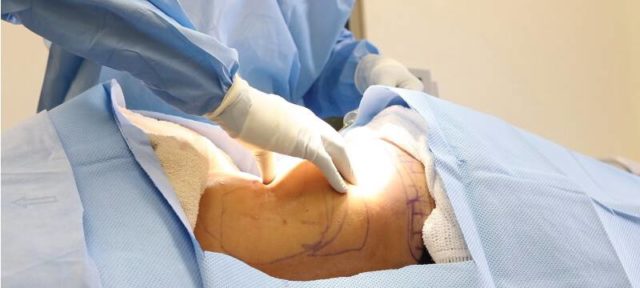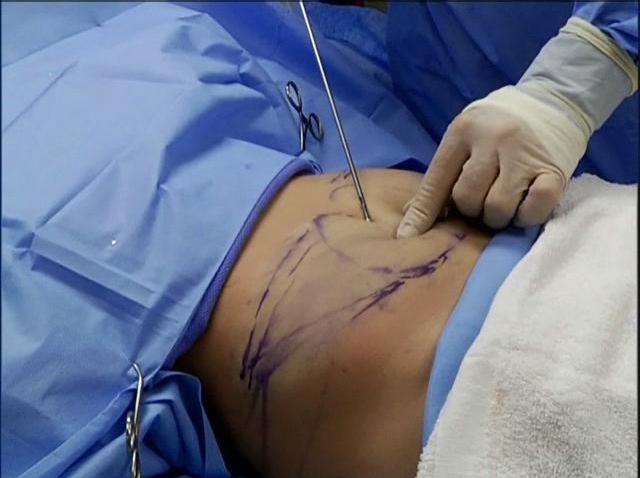
This type of plastic surgery has become very popular among women and involves the extracting of unwanted fats in some areas of the body. As in the chin, neck, arms, breasts, abdomen, buttocks, hips, thighs, knees, calves and ankles.
It is important to clarify that liposuction is not recommended in cases of severe obesity, since it is intended to correct regions of the body where accumulated fat remains, despite the performance of diets or exercises.
The technique to carry out liposuction is the aspiration of the fat by introducing a small hollow rod called a cannula that is connected to a vacuum machine or a special syringe.
With this rod, numerous tunnels are made in the area to be reduced. Generally, this operation only requires local anesthesia unless the area to be treated is very large or involves several parts of the body.
Once the operation is performed, a compression bandage or an elastic garment is used to keep the fabric in place.
It is normal for bruising and inflammation of the tissues in the aspirated area. The results of liposuction should not be evaluated before a minimum of three months has elapsed.
Who are the ideal candidates for liposuction?
They are those people who have a relatively normal weight, but who have fat clusters in localized areas.
The most important thing to get good results is a firm and elastic skin.
This procedure is not recommended for people who have undergone previous surgeries in the area to be treated, have poor circulation, and/or suffer from cardiac or respiratory problems.
Before surgery, the patient will have an initial consultation that includes a medical history, complete physical examination, and a psychological evaluation. Sometimes it is recommended to bring a next of kin or spouse during the medical appointment. A second consultation may be needed to give the patient time to think well about the intervention. Interested people should feel confident to ask questions. A knowledgeable individual is a better patient.
The entire procedure of liposuction and post-operative care must be understood. It is good to note that it can maybe improve patience and self-confidence but that it probably does not provide an ideal body.
What are the risks involved?

Certain pre-existing conditions should be monitored and controlled before liposuction, including:
- History of heart problems. (Heart disease)
- Arterial hypertension.
- Diabetes.
- Allergic reactions to different types of medications.
- Lung problems, difficulty breathing, air pockets in the bloodstream.
- Allergy (antibiotics, asthma, surgical preparation).
- Smoking alcohol or drug addiction.
There are also risks associated with liposuction, such as:
- Shock, generally when not enough fluid is replenished during the operative process.
- Liquid overload (caused by the procedure).
- Infections (caused by streptococci or staphylococci).
- Bleeding blood clots.
- Small fat globules in the bloodstream that block the flow of blood to the tissues (fat embolism).
- Nerve damage to skin, tissues or organs or burns due to heat or instruments used for liposuction.
- Uneven fat extraction (operative asymmetry).
- Reactions to medications or overdose by the lidocaine used in the procedure.
- Scars (the surface of the skin can be irregular, asymmetric or even loose especially in the elderly.
Types of liposuction.
Tumescent (liquid injection):
It is the most common type of liposuction and involves injecting a good amount of medicated solution in the areas to be operated before extracting the fat.
Sometimes you need to inject a volume up to three times greater than the volume of fat to be removed.
The liquid is a mixture of local anesthesia (lidocaine) a drug that constricts blood vessels (epinephrine) and an intravenous blood solution.
The lidocaine in the mixture helps numb the area during and after the operation and maybe the only anesthetic needed for the procedures.
Epinephrine helps reduce blood loss; the amount of bruises and the degree of swelling that this surgery produces.
The intravenous solution helps to extract the fat more easily and sucks it along with it. This type of liposuction is usually the one that takes the longest.
Super humid:
It is similar to tumescent liposuction. The difference is that not so much liquid is used during surgery, as the injection contains an amount equal to the amount of fat to be extracted.
Ultrasound-Assisted:
This procedure uses ultrasonic vibrations to liquefy the fat cells.


